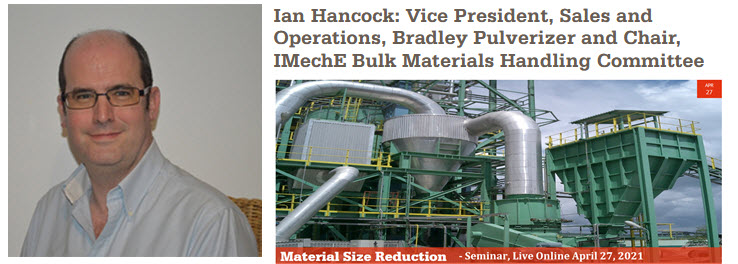We are excited for Bradley Pulverizer’s Vice President of Sales and Operations and Institute of Mechanical Engineers (IMechE) Chairman, Ian Hancock, to present Fundamentals of Air Classification at the Material Size Reduction live online seminar this April 27, 2021. Ian’s presentation will focus on 3 areas:
- The role of the classifier, different types, and their impact on classification efficiency
- Understanding the behavior of different materials to be sorted
- Basic understanding of cyclones and material separation post classifier
 As a preview to the upcoming seminar, we thought it would be interesting to interview Ian and share his thoughts behind why he chose this topic and how it relates to the overall theme of Material Size Reduction.
As a preview to the upcoming seminar, we thought it would be interesting to interview Ian and share his thoughts behind why he chose this topic and how it relates to the overall theme of Material Size Reduction.
In a nutshell, can you summarize what you will cover in your presentation on the Fundamentals of Air Classification?
Sure, I want to provide all attendees with a basic explanation of what air classification equipment is, how it operates, and what options are available for size reduction milling facilities. From there, I move onto the role air classifiers play in the size reduction operations and how differences in materials being processed should influence the selection of air classification equipment. Lastly, I will discuss ways that proper air classifier selection and optimization of classifiers can maximize efficiencies in both new processing lines and existing plants.
Why did you pick this topic for the Material Size Reduction seminar?
Throughout my 35 years in the field, I have repeatedly encountered size reduction mill systems running inefficiently due to air classification equipment that was specified and/or configured improperly. Unfortunately, the process of air classification is often overlooked because of its ‘passive’ role within a mill system, while the focus of attention goes to the ‘aggressive’ downstream pulverizing and upstream processing. It’s both a strange and unfortunate phenomenon because a properly specified and calibrated air classifier can often increase yields by 15%-18% with no additional power input required, resulting in an overall net lower cost per ton of material processed.
How can materials processors avoid making this same mistake or resolve current inefficiencies in their pulverizing plants?
I would encourage anyone designing a new milling system to consider multiple air classifier options and calculate the impact of each one on the performance of the system. In many cases, it helps to partner with an air classifier equipment manufacturer because they will most likely have an engineer on staff who can help with the calculations.
For existing milling systems, I would encourage regular inspections, maintenance, and performance evaluations to determine the efficiency of the entire mill system. In some cases, we’ve found that operator training may be all that’s needed for maintaining optimal running conditions. But, more times than not, we will identify opportunities for optimizing air flow within the classifier that will improve overall processing conditions. Lastly, because air classifiers are a relatively low-cost piece of equipment, there are times when investing in new equipment to achieve lower cost per ton makes the most sense economically.
Sign up for the IMechE Material Size Reduction seminar to attend Ian’s presentation and those of his peers

